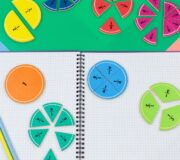8 Strategies For Answering SATs Questions [FREE POSTER]
At Third Space Learning, we’ve taught over 1 million lessons to over 100,000 unique pupils. In the process, we’ve overhauled our lesson structure and our intervention programmes to best support those who need us most.
With time and experience, we’ve honed our 8 actionable strategies for answering SATs questions, which you can take back to the classroom to prepare for SATs 2023!
These strategies have also been transformed into a free downloadable classroom poster, which you can find at the end of this blog.
SATs revision programme
In short, the aim of Third Space Learning’s Year 6 SATs revision programme is to prepare pupils for the tests themselves. It is therefore important to give pupils as much exposure as possible to the style of test questions.
Not only that, but the programme teaches them explicitly good test strategies to approach problems and practice using them, as well as speaking through them with their tutor.
The programme also focuses on the multiple techniques for asking the same question, which include:
- Ordering
- Comparing
- Matching columns
- Ticking boxes
This helps pupils to recognise that the underlying concept is the same, but might be asked in different ways.
Read more: Hundreds of SATs Questions [with answers]
Structure of SATs revision programme
The structure of our Year 6 maths revision programme actively supports our 8 strategies.
Pupils develop fluency at the beginning of each intervention lesson, followed by three sets of questions with additional support. The early questions are more focused on fluency, and the later questions involve more and more problem solving and reasoning.
We have structured our KS2 maths SATs revision into themes around broad concepts, such as place value.
The programme is a combination of diagnostic and teacher selection. We teach the highest impact lessons (that the pupil struggles with) first but also allow teachers to decide exactly which lessons they would like the pupil to complete if they so wish.
Third Space Learning’s interventions are designed to be tailored and to get results.
Set of 3: 75 Year 6 SATs Questions On Place Value, Fractions, Decimals & Percentages And Addition & Subtraction
Check understanding of KS2 SATs topics and target specific revision areas for pupils in your class.
Download Free Now!How and why has our SATs programme changed?
We have moved the SATs-style questions to the beginning of the lesson. We have also designed more specific support for that exact concept, plus added a second opportunity to consolidate.
Previously, the lessons included general support for revising a topic, followed by SATs questions. Now, it means our tutors can assess upfront what the student knows and doesn’t know and adapt the rest of the lesson accordingly.
In the new SATs programme, pupils are faced with a SATs question straight away, as they would in a test. This approach means the lesson focuses more on strategies, as the conversation is immediately about how to approach the questions and solve them step-by-step.
Why should we teach pupils how to answer exam questions?
- They need to practise approaching a test so that it feels more normal (such as isolating the keywords in a question)
- It lessens anxiety and gives them actionable methods of tackling a problem when they don’t know how to start
- It teaches metacognitive strategies (such as checking answers)
- It gives them tools to approach a question (rather than focusing on the concept)
8 strategies for SATs success
Now, for the strategies themselves!
We have 8 standardised strategies deployed throughout the lessons so that pupils get lots of practice with these during their time with us.
- Keywords
- Cross off
- Remember units
- Use a formula
- Use a diagram
- Check your answers
- Use the inverse
- Look out for marks
Strategy 1: Keywords

Finding the keywords gives us clues about what to do next.

Strategy 2: Cross off

Crossing off helps approach the problem systematically, meaning that steps are not missed or repeated, and silly mistakes are minimised.

Strategy 3: Remember units

We remind pupils to give their answers in full, including using units. For example, if the answer is 12 minutes, they should remember to write ‘minutes’. It’s worth noting that this is only used sometimes, as the answer box often includes the units in actual SATs papers!

Strategy 4: Use a formula

Pupils are given reminders where it might be helpful to call upon a formula.
For example:


Strategy 5: Use a diagram

Using a diagram or visual prompt helps pupils to visualise a question, such as using a bar model or array. In turn, this can help estimate what the answer size could be, identify the operation, or identify the final goal.

Strategy 6: Check your answers

This reminds you to double-check by working backwards and checking the answer makes sense, which also helps pick up any silly mistakes.

Strategy 7: Use the inverse

Using the inverse helps the pupil think about the relationship between addition and subtraction and multiplication and division to tackle this type of problem.

Strategy 8: Look out for marks

Looking out for marks is a clue that there will be more than one step to answer a particular question.

There you have it! We hope these 8 strategies will help you in the classroom and provide the foundation of your Year 6 SATs revision plan.
To easily share these SATs strategies with your class or colleagues, here is a member of the Third Space Learning team talking through all 8 of them!
If you want to keep reminding your class about these SATs strategies during their revision, you can also download a high-quality PDF version of the poster below for free!

Read more: What We’ve Learnt From Delivering One Million Online Lessons
DO YOU HAVE PUPILS WHO NEED MORE SUPPORT IN MATHS?
Every week Third Space Learning’s specialist primary maths tutors support thousands of students across hundreds of schools with weekly online 1 to 1 maths lessons designed to plug gaps and boost progress.
Since 2013 these personalised one to one lessons have helped over 150,000 primary and secondary students become more confident, able mathematicians.
Learn about the SATs revision programme or request a personalised quote for your school to speak to us about your school’s needs and how we can help.





